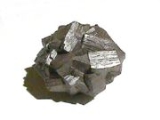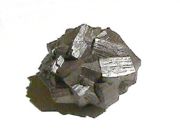
Pseudomorph
Encyclopedia
In mineralogy
, a pseudomorph is a mineral
or mineral compound that appears in an atypical form (crystal system
), resulting from a substitution process in which the appearance and dimensions remain constant, but the original mineral is replaced by another. The name literally means "false form".
Terminology for pseudomorphs is "replacer after original", as in brookite after rutile.

or opal
) to form petrified wood
in which the substitution may be so perfect as to retain the original cellular structure of the wood. An example of mineral-to-mineral substitution is replacement of aragonite
twin
crystals by native copper
, as occurs at Corococo, Bolivia
.
A variety of infiltration or substitution pseudomorphism is called alteration, in which only partial replacement occurs. This happens typically when a mineral of one composition changes by chemical reaction to another of similar composition, retaining the original crystalline shape. An example is a change from galena
, lead sulfide, to anglesite
, lead sulfate. The resulting pseudomorph may contain an unaltered core of galena surrounded by anglesite that has the cubic crystal shape of galena.
to calcite
change.
. Fossil
s are often formed by pseudomorphic replacement of the remains by mineral matter. Examples include petrified wood
and pyritized
gastropod shells.
In biology
, a pseudomorph is a cloud of mucus-rich ink released by many species of cephalopod
. The name refers to the similarity in appearance between the cephalopod that released it and the cloud itself, in this context meaning literally "false body." This behaviour often allows the cephalopod to escape from predation unharmed, and is often performed as part of what is known as the Blanch-Ink-Jet Maneuver
.
Mineralogy
Mineralogy is the study of chemistry, crystal structure, and physical properties of minerals. Specific studies within mineralogy include the processes of mineral origin and formation, classification of minerals, their geographical distribution, as well as their utilization.-History:Early writing...
, a pseudomorph is a mineral
Mineral
A mineral is a naturally occurring solid chemical substance formed through biogeochemical processes, having characteristic chemical composition, highly ordered atomic structure, and specific physical properties. By comparison, a rock is an aggregate of minerals and/or mineraloids and does not...
or mineral compound that appears in an atypical form (crystal system
Crystal system
In crystallography, the terms crystal system, crystal family, and lattice system each refer to one of several classes of space groups, lattices, point groups, or crystals...
), resulting from a substitution process in which the appearance and dimensions remain constant, but the original mineral is replaced by another. The name literally means "false form".
Terminology for pseudomorphs is "replacer after original", as in brookite after rutile.

Substitution pseudomorph
An infiltration pseudomorph, or substitution pseudomorph is a pseudomorph in which one mineral or other material is replaced by another. The original shape of the mineral remains unchanged, but color, hardness, and other properties change to those of the replacing mineral. An example of this process (also called substitution) is the replacement of wood by silica (quartzQuartz
Quartz is the second-most-abundant mineral in the Earth's continental crust, after feldspar. It is made up of a continuous framework of SiO4 silicon–oxygen tetrahedra, with each oxygen being shared between two tetrahedra, giving an overall formula SiO2. There are many different varieties of quartz,...
or opal
Opal
Opal is an amorphous form of silica related to quartz, a mineraloid form, not a mineral. 3% to 21% of the total weight is water, but the content is usually between 6% to 10%. It is deposited at a relatively low temperature and may occur in the fissures of almost any kind of rock, being most...
) to form petrified wood
Petrified wood
Petrified wood is the name given to a special type of fossilized remains of terrestrial vegetation. It is the result of a tree having turned completely into stone by the process of permineralization...
in which the substitution may be so perfect as to retain the original cellular structure of the wood. An example of mineral-to-mineral substitution is replacement of aragonite
Aragonite
Aragonite is a carbonate mineral, one of the two common, naturally occurring, crystal forms of calcium carbonate, CaCO3...
twin
Crystal twinning
Crystal twinning occurs when two separate crystals share some of the same crystal lattice points in a symmetrical manner. The result is an intergrowth of two separate crystals in a variety of specific configurations. A twin boundary or composition surface separates the two crystals....
crystals by native copper
Native copper
Copper, as native copper, is one of the few metallic elements to occur in uncombined form as a natural mineral, although most commonly occurs in oxidized states and mixed with other elements...
, as occurs at Corococo, Bolivia
Bolivia
Bolivia officially known as Plurinational State of Bolivia , is a landlocked country in central South America. It is the poorest country in South America...
.
A variety of infiltration or substitution pseudomorphism is called alteration, in which only partial replacement occurs. This happens typically when a mineral of one composition changes by chemical reaction to another of similar composition, retaining the original crystalline shape. An example is a change from galena
Galena
Galena is the natural mineral form of lead sulfide. It is the most important lead ore mineral.Galena is one of the most abundant and widely distributed sulfide minerals. It crystallizes in the cubic crystal system often showing octahedral forms...
, lead sulfide, to anglesite
Anglesite
Anglesite is a lead sulfate mineral with the chemical formula PbSO4. It occurs as an oxidation product of primary lead sulfide ore, galena. Anglesite occurs as prismatic orthorhombic crystals and earthy masses, and is isomorphous with barite and celestine. It contains 74% of lead by mass and...
, lead sulfate. The resulting pseudomorph may contain an unaltered core of galena surrounded by anglesite that has the cubic crystal shape of galena.
Paramorph
A paramorph (also called allomorph) is a mineral changed on the molecular level only. It has the same chemical composition, but with a different structure. The mineral looks identical to the original unaltered form. This occurs, as an example, in the aragoniteAragonite
Aragonite is a carbonate mineral, one of the two common, naturally occurring, crystal forms of calcium carbonate, CaCO3...
to calcite
Calcite
Calcite is a carbonate mineral and the most stable polymorph of calcium carbonate . The other polymorphs are the minerals aragonite and vaterite. Aragonite will change to calcite at 380-470°C, and vaterite is even less stable.-Properties:...
change.
Perimorph and incrustation pseudomorph
An incrustation pseudomorph, also called perimorph, results from a process by which a mineral is coated by another and the encased mineral dissolves. The encasing mineral remains intact, and retains the shape of the original mineral or material. Alternatively, another mineral may fill the space (the mold) previously occupied by some other mineral or material.Pseudomorph in other fields
Pseudomorphs are also common in paleontologyPaleontology
Paleontology "old, ancient", ὄν, ὀντ- "being, creature", and λόγος "speech, thought") is the study of prehistoric life. It includes the study of fossils to determine organisms' evolution and interactions with each other and their environments...
. Fossil
Fossil
Fossils are the preserved remains or traces of animals , plants, and other organisms from the remote past...
s are often formed by pseudomorphic replacement of the remains by mineral matter. Examples include petrified wood
Petrified wood
Petrified wood is the name given to a special type of fossilized remains of terrestrial vegetation. It is the result of a tree having turned completely into stone by the process of permineralization...
and pyritized
Pyrite
The mineral pyrite, or iron pyrite, is an iron sulfide with the formula FeS2. This mineral's metallic luster and pale-to-normal, brass-yellow hue have earned it the nickname fool's gold because of its resemblance to gold...
gastropod shells.
In biology
Biology
Biology is a natural science concerned with the study of life and living organisms, including their structure, function, growth, origin, evolution, distribution, and taxonomy. Biology is a vast subject containing many subdivisions, topics, and disciplines...
, a pseudomorph is a cloud of mucus-rich ink released by many species of cephalopod
Cephalopod
A cephalopod is any member of the molluscan class Cephalopoda . These exclusively marine animals are characterized by bilateral body symmetry, a prominent head, and a set of arms or tentacles modified from the primitive molluscan foot...
. The name refers to the similarity in appearance between the cephalopod that released it and the cloud itself, in this context meaning literally "false body." This behaviour often allows the cephalopod to escape from predation unharmed, and is often performed as part of what is known as the Blanch-Ink-Jet Maneuver
Cephalopod ink
Cephalopod ink is a dark pigment released into water by most species of cephalopod, usually as an escape mechanism. All cephalopods, with the exception of the Nautilidae and the species of octopus belonging to the suborder Cirrina, are able to release ink....
.

